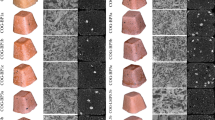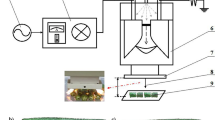Abstract
Cactus pear fruit consists of the peel, seeds and pulp. The peel is a major waste in cactus pear pulp based products accounting about 37.72% of the fruit weight. The aim of this study was to utilized and characterized the physicochemical and rheological properties of biscuits substituted with extracted cactus pear peel (CPP) and alcohol-insoluble solids (AIS) from cactus pear (Opuntia ficus-indica). To prepare AIS, peels were shredded and dropped in ethanol (70%) for 15 min. The mixture was boiled at 70 °C for 30 min, filtered and washed with ethanol 70% and the washing repeated until no sugars. The residue was washed and dried at room temperature. Changes in physiochemical and rheological properties of extracted CPP and AIS from cactus pear to qualify determine their use in the production of them to produce a fiber-rich food product. The water-holding capacity was 3.7 ml/g for the peel and 1.5 ml/g for the AIS, and the oil-holding capacity was approximately the same for both the CPP and AIS. The protein content was 3.5% for the CPP and 3.72% for the AIS. The CPP and AIS contained little fat (1.22% and 1.44%, respectively). Potassium and calcium in the AIS had the highest concentration, at 21.49 g/kg and 44.04 g/kg, respectively, and these minerals were found at 22.07 g/kg and 16.66 g/kg, respectively, in the CPP. The dominant phenolic compounds found in the CPP were pyrogallol, catechol, catechin, and alpha-coumaric acid. The results showed that the AIS contained pyrogallol (61.67 ppm), benzoic acid (10.68 ppm), vanillic acid (7.66 ppm), catechin (4.65 ppm) and salicylic acid (4.51 ppm). The CPP was rich in glucose (25.95%) and fructose (21.36%) compared to the AIS. The sensory evaluation indicated that 7.5% dried cactus pear peel or 7.5% AIS can be successfully used in substitution of wheat flour biscuits. It could be conducted cactus pear as major by-product can be important for the industrial utilization.

Similar content being viewed by others
References
Anil M (2007) Using of hazelnut testa as a source of dietary fiber in breadmaking. J Food Eng 80:61–67
Anwar M, Sallam E (2016) Utilization of prickly pear peels to improve quality of pan bread. Arab J Nucl Sci Appl 49:151–163
Askar A, Treptow H (2013) Quality assurance in tropical fruit processing. Springer Science & Business Media, Berlin
Borroto B, Larrauri J, Cribeiro A (1995) Particle size influence on water holding capacity of citrus and pineapple fiber. Alimentaria (Spanish)
Capouchová I et al (2012) Effect of different intensities of Fusarium infestation on grain yield, deoxynivalenol content and baking quality of winter wheat. Rom Agric Res 29:297–306
Cerezal P, Duarte G (2005) Use of skin in the elaboration of concentrated products of cactus pear (Opuntia ficus-indica (L.) Miller). J Prof Assoc Cactus Dev 7:61–83
Chau C-F, Huang Y-L (2003) Comparison of the chemical composition and physicochemical properties of different fibers prepared from the peel of Citrus sinensis L. Cv. Liucheng J Agric Food Chem 51:2615–2618
Collar C, Bollain C, Rosell C M (2007) Rheological behaviour of formulated bread doughs during mixing and heating. Food Sci Technol Int 13:99–107
Dhaka V, Gulia N, Khatkar B (2012) Application of mixolab to assess the bread making quality of wheat varieties. Sci Rep 1:183
El Kossori RL, Villaume C, El Boustani E, Sauvaire Y, Méjean L (1998) Composition of pulp, skin and seeds of prickly pears fruit (Opuntia ficus indica sp.). Plant Foods Hum Nutr 52:263–270
El-Said NM, Nagib AI, Rahman ZA, Deraz SF (2010) Prickly pear [Opuntia ficus-indica (L.) Mill] peels: chemical composition, nutritional value, and protective effects on liver and kidney functions and cholesterol in rats. Funct Plant Sci Biotechnol 5:30–35
Gebremariam T, Melaku S, Yami A (2006) Effect of different levels of cactus (Opuntia ficus-indica) inclusion on feed intake, digestibility and body weight gain in tef (Eragrostis tef) straw-based feeding of sheep. Anim Feed Sci Technol 131:43–52
Goupy P, Hugues M, Boivin P, Amiot MJ (1999) Antioxidant composition and activity of barley (Hordeum vulgare) and malt extracts and of isolated phenolic compounds. J Sci Food Agric 79:1625–1634
Habibi Y, Mahrouz M, Vignon MR (2002) Isolation and structure of D-xylans from pericarp seeds of Opuntia ficus-indica prickly pear fruits. Carbohydr Res 337:1593–1598
Habibi Y, Heyraud A, Mahrouz M, Vignon M (2004) Structural features of pectic polysaccharides from the skin of Opuntia ficus-indica prickly pear fruits. Carbohydr Res 339:1119–1127
Hadnađev TD, Torbica A, Hadnađev M (2011) Rheological properties of wheat flour substitutes/alternative crops assessed by Mixolab. Procedia Food Sci 1:328–334
Hooda S, Jood S (2005) Organoleptic and nutritional evaluation of wheat biscuits supplemented with untreated and treated fenugreek flour. Food Chem 90:427–435
Hunter RS (1958) Description and measurement of white surfaces. JOSA 48:597–605
Kuniak L, Marchessault R (1972) Study of the crosslinking reaction between epichlorohydrin and starch. Starch-Stärke 24:110–116
Lahsasni S, Kouhila M, Vighon M, Mahrouz M (2004) Impact of convective solar drying on the color and the composition out of free sugars of the cladode, the peel and the fruit of a cactus inerme of Opuntia ficus indica. Phys Chem News 18:89
Loomis WD (1974) Overcoming problems of phenolics and quinones in the isolation of plant enzymes and organelles. In: Methods in enzymology, vol 31. Academic Press, New York, pp 528-544
Mertens D (2005) AOAC official method 975.03. In: Horwitz W, Latimer GW (eds) Metal in plants and pet foods. Official Methods of Analysis, 18th ed, pp 3–4
Namir M, Siliha H, Ramadan MF (2015) Fiber pectin from tomato pomace: characteristics, functional properties and application in low-fat beef burger. J Food Meas Charact 9:305–312
Namir M, Elzahar K, Ramadan MF, Allaf K (2017) Cactus pear peel snacks prepared by instant pressure drop texturing: effect of process variables on bioactive compounds and functional properties. J Food Meas Charact 11:388–400
Nie NH, Bent DH, Hull CH (1970) SPSS: statistical package for the social sciences. McGraw-Hill, New York
Nnam NM, Nwokocha MO (2003) Chemical and organoleptic evaluation of biscuits madefrom mixtures of hungry rice, acha (Digitaria exilis), sesame (Sesamum indicum) and breadfruit (Artocarpus atilis) flours. Plant Foods Hum Nutr 58:1–11
Osorio-Esquivel O, Álvarez VB, Dorantes-Álvarez L, Giusti MM (2011) Phenolics, betacyanins and antioxidant activity in Opuntia joconostle fruits. Food Res Int 44:2160–2168
Parrott ME, Thrall BE (1978) Functional properties of various fibers: physical properties. J Food Sci 43:759–763
Pomeranz Y, Shogren M, Finney K, Bechtel D (1977) Fiber in breadmaking—effects on functional properties. Cereal Chem
Rosell CM, Foegeding A (2007) Interaction of hydroxypropylmethylcellulose with gluten proteins: small deformation properties during thermal treatment. Food Hydrocoll 21:1092–1100
Rosell CM, Santos E, Collar C (2010) Physical characterization of fiber-enriched bread doughs by dual mixing and temperature constraint using the Mixolab®. Eur Food Res Technol 231:535–544
Sáenz C, Berger H (2006) Utilización agroindustrial del nopal, vol 162. Food and Agriculture Organisation
Sáenz C, Estévez A, Sepúlveda E, Mecklenburg P (1998) Cactus pear fruit: a new source for a natural sweetener. Plant Foods Hum Nutr 52:141–149
Salim N, Abdelwaheb C, Rabah C, Ahcene B (2009) Chemical composition of Opuntia ficus-indica (L.) fruit. Afr J Biotechnol 8(8): 1623–1624
Shih L, Chen L-G, Yu T-S, Chang W-T, Wang S-L (2003) Microbial reclamation of fish processing wastes for the production of fish sauce. Enzyme Microb Technol 33:154–162
Sudha M, Baskaran V, Leelavathi K (2007) Apple pomace as a source of dietary fiber and polyphenols and its effect on the rheological characteristics and cake making. Food Chem 104:686–692
Thebaudin J, Lefebvre A, Harrington M, Bourgeois C (1997) Dietary fibres: nutritional and technological interest. Trends Food Sci Technol 8:41–48
Thomas M, Crépeau M, Rumpunen K, Thibault J-F (2000) Dietary fibre and cell-wall polysaccharides in the fruits of Japanese quince (Chaenomeles japonica). LWT-Food Sci Technol 33:124–131
Toma R, Orr P, D’appolonia B, Dlntzis F, Tabekhia M (1979) Physical and chemical properties of potato peel as a source of dietary fiber in bread. J Food Sci 44:1403–1407
Vergara-Valencia N, Granados-Pérez E, Agama-Acevedo E, Tovar J, Ruales J, and Bello-Pérez L A (2007) Fibre concentrate from mango fruit: Characterization, associated antioxidant capacity and application as a bakery product ingredient. LWT - Food Sci Technol 40:722–729
Author information
Authors and Affiliations
Corresponding author
Additional information
Publisher's Note
Springer Nature remains neutral with regard to jurisdictional claims in published maps and institutional affiliations.
Rights and permissions
About this article
Cite this article
El-Shahat, M.S., Rabie, M.A., Ragab, M. et al. Changes on physicochemical and rheological properties of biscuits substituted with the peel and alcohol-insoluble solids (AIS) from cactus pear (Opuntia ficus-indica). J Food Sci Technol 56, 3635–3645 (2019). https://doi.org/10.1007/s13197-019-03805-7
Revised:
Accepted:
Published:
Issue Date:
DOI: https://doi.org/10.1007/s13197-019-03805-7




